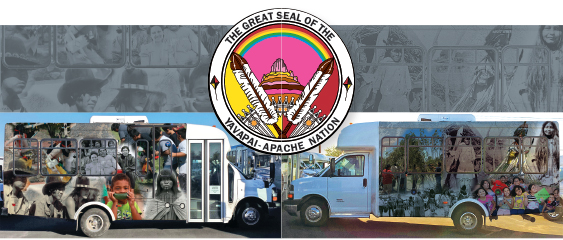
EDITOR NOTE: YAT opened in early April. At the eleventh hour of production for this issue, the Camp Verde Bugle, Camp Verde, AZ, provided BUSRide the basic content of this coverage with permission from Editor Dan Engler and Managing Editor Raquel Hendrickson.
Though its primary purpose is to provide transportation for tribal members between Camp Verde and Clarkdale in this stretch of central Arizona known as the Verde Valley, the anxiously-awaited Yavapai-Apache Transit (YAT), Clarkdale, AZ, will serve as a vital link for all the residents in this region.
Officially launched in early April, YAT is now transporting all Verde Valley residents needing rides between Camp Verde and Clarkdale, and connecting to other Verde Valley communities with matching fares from CAT and Verde Lynx.
—————————————————————————————————————————————
YOU MIGHT ALSO LIKE:
- Proterra debuts second generation 40-foot all-electric transit bus
- Busworld Kortrijk goes electric
- All-electric transit has arrived
—————————————————————————————————————————————
According to Transit Manager Diana Bonnaha, YAT opened with two shuttle buses with seating for 14 passengers each with capacity for wheelchairs. In Cottonwood, YAT links with the Cottonwood Area Transit (CAT) system and Verde Lynx for service into the Sedona area. In Camp Verde, YAT links to the Beaver Creek volunteer bus program.
“The transit systems have worked hard to coordinate the routes and fares,” Bonnaha says. “This entire project is about the great way everyone has joined together to make this work.”
While remaining a distinctive service for the Tribal Nation, YAT is considered the next big step in Verde Valley transit.
The idea of a transit system for YA Nation arose from the need for tribal-member transportation between the YA Nation communities in Clarkdale and Camp situated in the Verde Valley in central Arizona. In 2006, the Federal Transit Administration (FTA) awarded the YA Nation a grant to begin the two-year planning process.
According to YA Nation Contracts and Grants Administrator Robert Mills, there was discussion about one stop in Cottonwood as YAN introduced its plans to the Verde Valley communities.
An implementation grant enabled YAN to hire its first manager (Bonnaha) and two part-time drivers, Ron Juan and Fawn Stanley. Yavapai-Apache Transit then became part of the discussion for the Verde Valley Transportation Committee.
Juan and Stanley have been training with Bonnaha to learn the shuttles and the procedures. They have also trained with CAT personnel as the launch date neared. Bonnaha wanted the design of the shuttle to reflect the past and future of the Yavapai-Apache Nation and enlisted Apphia Shirley to create the colorful exteriors.
“I’m excited about this aspect,” says CAT Coordinator Bruce Morro. “This gives people anywhere in Camp Verde the opportunity to get to Sedona.”
A valley-wide transit network had long been seen as a community need in this region of the state, but too expensive for the various municipalities to piece together anytime soon. However, through the government resources available to YA Nation, what could be accomplished if CAT/Verde Lynx teamed with Yavapai-Apache Transit became clear.
As the system progressed, Morrow worked closely with Bonnaha.
“We helped YA Nation in putting its policies and procedures in place, as well as job descriptions; all the details,” Morrow says. “It’s not easy for an agency first starting out, and YA Transit was basically starting with nothing.”
From Camp Verde, the northbound route starts on the reservation at the YAN Medical Clinic with stops at Public Works, Social Services, the Administration building and onto Cliff Castle Casino.
Shuttle stops at the Camp Verde Post Office run down Main Street to Bear Street, then on the 260 bypass to Goswick Way near the intersection of State Route 260 and Interstate 17.
Heading toward Cottonwood, the shuttle makes stops on the Tun Lii reservation area off Cherry Road before heading back across 260 to the Yavapai County court and jail complex.
In Cottonwood, stops include Wal-Mart, Safeway plaza, Cottonwood Public Library (which serves as the transfer station), and Verde Valley Medical Center before arriving at the tribal community in Clarkdale. The estimated time from fleet building to fleet building is 42 minutes. The southbound shuttle back to Camp Verde follows the same route in reverse.
Each trip is $1.25. There will be 10-day passes and monthly passes available, good for transferring to CAT/Lynx, with purchase stations on the reservation and possibly at Camp Verde Town Hall.
According to Morrow, YA Transit is matching the CAT schedule as close as possible on a route that runs for an hour-and-a-half.
The stop at the jail was of particular interest in the wake of controversy over released people trying to get a ride home or endure the so-called “walk of shame.” Bonnaha said Clarkdale Town Manager Gayle Mabery first voiced the idea of a shuttle stop there.
Tribal members are the priority of Yavapai-Apache Transit. The first run of the day is dedicated to getting tribal members to work. The last run of the day is to get them back home.
However, Bonnaha says YAT will also be working closely with Verde Valley Caregivers to provide rides. YAT says it operates Monday through Friday and will always be closed on tribal holidays.
Setting up the routes and coordinating with other systems has been a long and complicated process. Bonnaha expects some trial and error as the system goes online.
“There will be adjustments made as we go,” she says. “Transit systems, big and small, have to make adjustments all of the time.”
Mills said the YAN could qualify for one more continuation grant. After that, the Bureau of Indian Affairs would pick up the costs of running the transit system.
